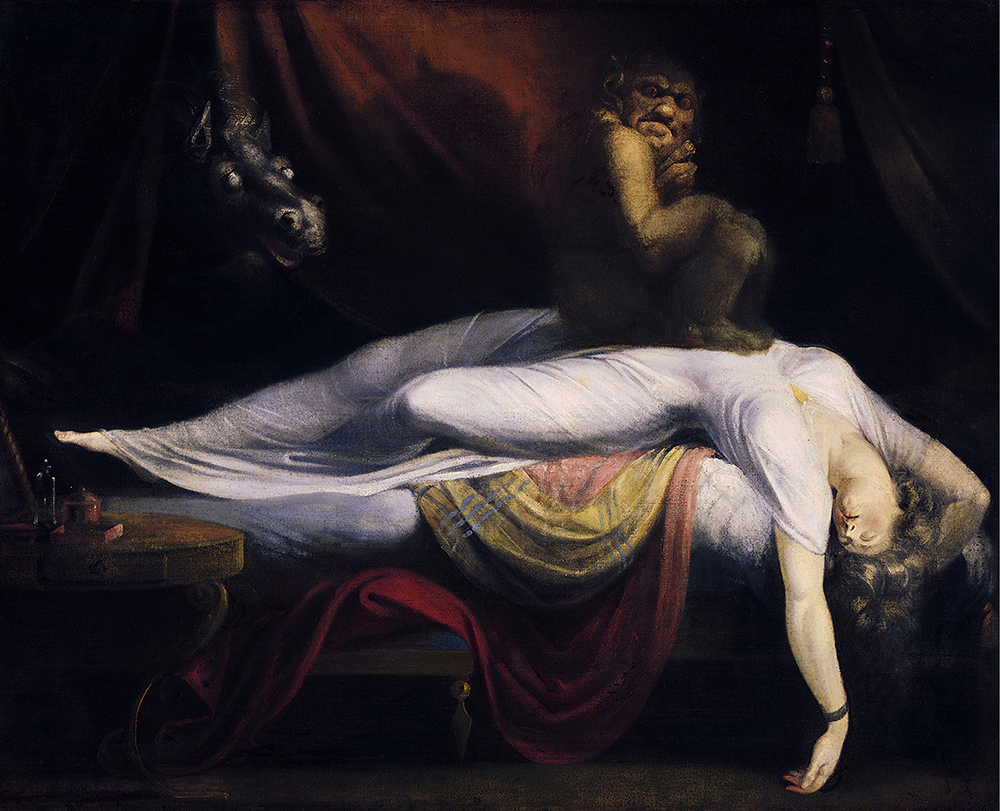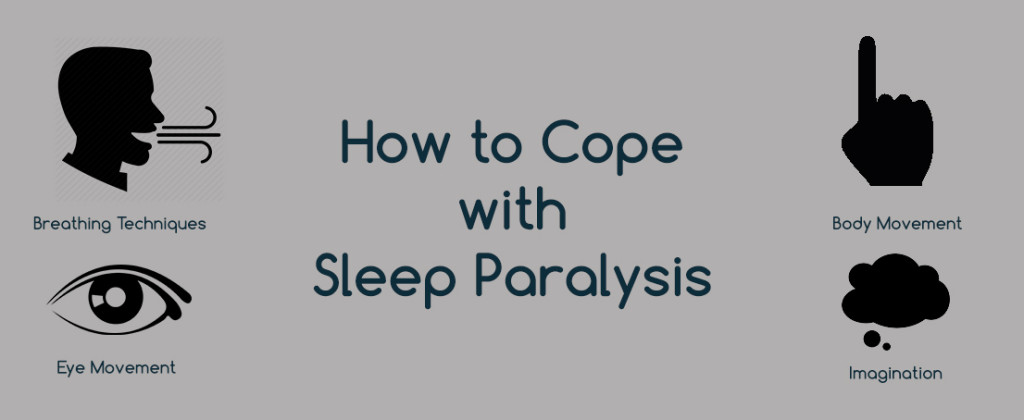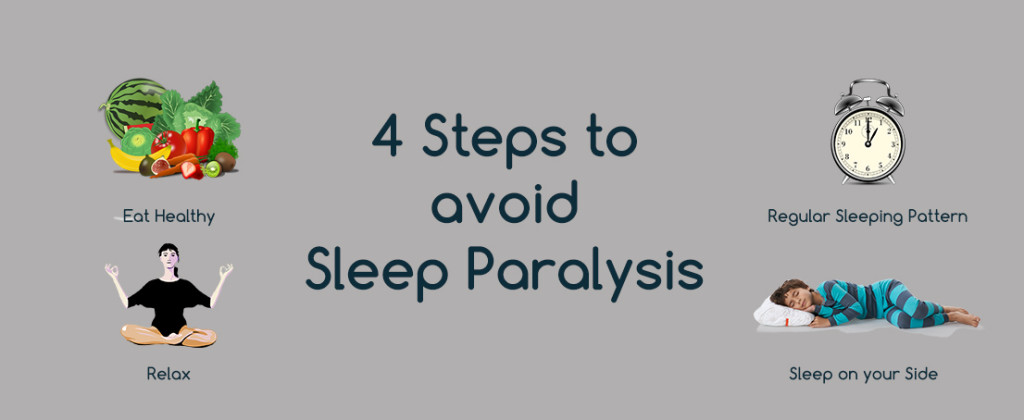Sleep Paralysis
If you have ever experienced this phenomena, you will know it is an intensely terrifying experience. Sleep paralysis usually happens when either entering or waking up from REM sleep. When you enter REM sleep, your brain tells your body’s voluntary muscles to relax into a state called atonia (a lack of normal muscle tension). Atonia helps the body causing itself injury, preventing you from acting out the physical movements happening in your dreams.
During sleep paralysis the body remains paralysed in REM atonia when the brain has awoken. Patients are in a conscious state but are unable to move their voluntary muscles or speak. Patients are likely to feel an intense chest pressure – which has often been compared to someone pushing down on their chest.
Folklore
There are many cultural references to sleep paralysis in different folklore, demonstrating that this is a phenomenon that has been happening for centuries. The ‘Night Hag’ is a creature described in many different folklores, and is used to explain sleep paralysis. Usually depicted as a decrepit old woman, we have seen the image carried through and mentioned in many different cultures.
British, Scandinavian and Newfoundland folklore describe the old hag as leaving her own body behind in the night time, and her soul seeks out her victims and sits on their ribcage, causing them night terrors and difficulty breathing because of the heavy, invisible weight on their chest. In many cultures the hag is known as the ‘Mare’ – which is where the word nightmare that we use so often today has come from.
In Figi, the experience has been interpreted as being eaten by a demon, and similarly in African communities the experience has been referred to as “The Devil on your Back”. Turkey also refers to sleep paralysis as being a demonic occurrence, named ‘Karabasan’ and the demon in question being known as ‘Jinn’. They believe Jinn comes to their rooms at night, holds them down hard enough to stop them from moving and starts to strangle the victim. In Thai folklore refers to a ghost known as Phi Am, with some even claiming that the ghost in question can leave bruises.
Culture
Unsurprisingly due to its terrifying nature, there have been numerous books written and films made about sleep paralysis over the years, trying to recreate the sheer terror that people experience during this phenomenon.
The Swedish film Marianne examines the folklore surrounding sleep paralysis, telling the story of a mans mental state after the death of his wife, who suffers from sleep paralysis and believes he is being haunted by ‘The Mare’. The film explores the folklore surrounding ‘The Mare’, describing the feeling that many people get during sleep paralysis – that there is a presence in the room, someone sitting on their chest or watching them.
‘The Nightmare’ premiered earlier this year at the Sundance Film Festival, and focuses on eight different sufferers of sleep paralysis, interviewing each about their experiences and depicting their stories in film with professional actors.
Increased Risk
There are many different factors that have been linked to the increased risk of sleep paralysis.
Age: Sleep paralysis is a lot more common in young people because of the fluctuation of hormones in the body.
Sleep Deprivation: Sleep paralysis is much more common in people with insomnia who don’t get enough sleep. Sleep paralysis usually happens when the person enters REM sleep prematurely, which is more likely to happen when you are sleep deprived.
Diet: Your diet will have n impact on your sleep whether you are a sleep paralysis sufferer or not. The chemicals in caffeine, fast foods and sweets will impact on your REM sleep cycle.
Irregular sleeping patterns: If you have an irregular sleeping pattern, for example if you are a shift worker, you are much more likely to suffer from sleep paralysis as the brain is unable to regulate sleeping and waking patterns normally.
Narcolepsy: People suffering from narcolepsy are more likely to suffer from sleep paralysis because they have no regular sleeping habits. Narcolepsy is a rare, long term brain disorder which causes the patient to fall asleep at irregular and inappropriate times.
Sleeping Positions: There has been patterns in the sufferers of sleep paralysis and them sleeping in the supine position – lying on your back.
Other factors can include stress; overuse of stimulants, physical fatigue and certain medication for ADHD.
How to Cope
There are a few steps we recommend taking during sleep paralysis.
1. Body Movement
Although most sleep paralysis sufferers believe their whole body to be paralysed during an attack – this isn’t always true. Often you will find yourself to be able to move at least one part of your body – usually a finger, toe or your tongue. Move whichever you can to force yourself in to a fully awake state.
2. Eye Movement
During sleep paralysis it is very rare for the sufferer to not be able to move their eyes. It has been indicated by sufferers that if you fully focus on moving your eyes back and forth, that you can wake yourself up from sleep paralysis and return to a fully awake state.
3. Breathing
Controlled breathing is one of the best relaxation techniques, but it can be hard to focus on this during a sleep paralysis attack due to the feeling of pressure on your chest. However – if you practice different breathing techniques in advance may help you to gain control of your breathing during sleep paralysis, similar to sufferers of panic attacks.
4. Imagination
A lot of sufferers of sleep paralysis will try to imagine themselves moving in an aid to break them from the paralysed state.
We also have some recommended steps to reduce the risk of sleep paralysis:
1. Eating Healthy
It sounds like an obvious one, but the chemicals in fast foods, alcohol, caffeine and sweets will affect your sleep and impact your REM cycle. Introduce a more healthy diet and you may find that your sleeping cycle will improve.
2.Sleep on Your Side
About 60% of sleep paralysis attacks happen when the person is sleeping on their back in the supine position. Sleep on your side or front to reduce the risk of attacks.
3. Regular Sleeping
Introduce a more regular sleeping routine to your life. Sleep paralysis is more likely in those that have more irregular sleeping patterns, so trying to maintain a healthy sleeping pattern will reduce your risk of attacks.
4. Relaxation
Stress is a factor for sleep paralysis sufferers, as it interrupts normal sleeping cycles. Meditation, playing with a pet, reading a book before bed – or of course listening to Relaxing Records with our sleep music playlists!
http://www.youtube.com/user/relaxingrecords
We hope these points help you if you are suffering from sleep paralysis. Tell us your sleep paralysis stories on the Relaxing Records Facebook page!




